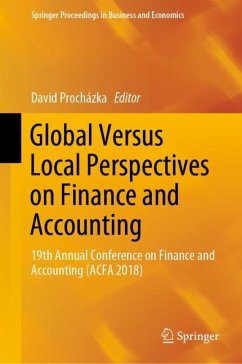Global Versus Local Perspectives on Finance and Accounting
19th Annual Conference on Finance and Accounting (ACFA 2018)
Herausgegeben:Procházka, David
Global Versus Local Perspectives on Finance and Accounting
19th Annual Conference on Finance and Accounting (ACFA 2018)
Herausgegeben:Procházka, David
- Gebundenes Buch
- Merkliste
- Auf die Merkliste
- Bewerten Bewerten
- Teilen
- Produkt teilen
- Produkterinnerung
- Produkterinnerung
This proceedings volume examines accounting and financial issues and trends from both global and local economic perspectives. Featuring selected contributions presented at the 19th Annual Conference on Finance and Accounting (ACFA) held in Prague, Czech Republic, this book offers a mixture of research methods and micro- and macroeconomic approaches to depict a detailed picture of the impact of global and local determinants on the globalized economy. The global perspectives versus local specifics make the volume useful for not only academics and scholars, but also for regulators and policy…mehr
Andere Kunden interessierten sich auch für
![The Impact of Globalization on International Finance and Accounting The Impact of Globalization on International Finance and Accounting]() The Impact of Globalization on International Finance and Accounting108,99 €
The Impact of Globalization on International Finance and Accounting108,99 €![Advances in Finance & Applied Economics Advances in Finance & Applied Economics]() Advances in Finance & Applied Economics97,99 €
Advances in Finance & Applied Economics97,99 €![Locational Analysis of Firms' Activities from a Strategic Perspective Locational Analysis of Firms' Activities from a Strategic Perspective]() Locational Analysis of Firms' Activities from a Strategic Perspective38,99 €
Locational Analysis of Firms' Activities from a Strategic Perspective38,99 €![Economy, Finance and Business in Southeastern and Central Europe Economy, Finance and Business in Southeastern and Central Europe]() Economy, Finance and Business in Southeastern and Central Europe113,99 €
Economy, Finance and Business in Southeastern and Central Europe113,99 €![Economic and Financial Challenges for Eastern Europe Economic and Financial Challenges for Eastern Europe]() Economic and Financial Challenges for Eastern Europe113,99 €
Economic and Financial Challenges for Eastern Europe113,99 €![Entwicklung einer Methodik zur systematischen Bewertung der Wertschöpfung in der Bauausführung Entwicklung einer Methodik zur systematischen Bewertung der Wertschöpfung in der Bauausführung]() Hendrik JonitzEntwicklung einer Methodik zur systematischen Bewertung der Wertschöpfung in der Bauausführung84,99 €
Hendrik JonitzEntwicklung einer Methodik zur systematischen Bewertung der Wertschöpfung in der Bauausführung84,99 €![Framing Effects in Taxation Framing Effects in Taxation]() Stefan TraubFraming Effects in Taxation77,99 €
Stefan TraubFraming Effects in Taxation77,99 €-
-
-
This proceedings volume examines accounting and financial issues and trends from both global and local economic perspectives. Featuring selected contributions presented at the 19th Annual Conference on Finance and Accounting (ACFA) held in Prague, Czech Republic, this book offers a mixture of research methods and micro- and macroeconomic approaches to depict a detailed picture of the impact of global and local determinants on the globalized economy. The global perspectives versus local specifics make the volume useful for not only academics and scholars, but also for regulators and policy makers when deliberating the potential outcome of competing regulatory mechanisms.
The Annual Conference on Finance and Accounting (ACFA) has become one of the biggest conferences in the Central and Eastern European (CEE) region solely oriented to contemporary research in finance and accounting. Bringing together researchers and scholars from all over the world, the conference provides a platform in which thoughts, visions, and contemporary developments in the field of finance and accounting are discussed.
The Annual Conference on Finance and Accounting (ACFA) has become one of the biggest conferences in the Central and Eastern European (CEE) region solely oriented to contemporary research in finance and accounting. Bringing together researchers and scholars from all over the world, the conference provides a platform in which thoughts, visions, and contemporary developments in the field of finance and accounting are discussed.
Produktdetails
- Produktdetails
- Springer Proceedings in Business and Economics
- Verlag: Springer / Springer International Publishing / Springer, Berlin
- Artikelnr. des Verlages: 978-3-030-11850-1
- 1st edition 2019
- Seitenzahl: 408
- Erscheinungstermin: 1. März 2019
- Englisch
- Abmessung: 241mm x 160mm x 28mm
- Gewicht: 772g
- ISBN-13: 9783030118501
- ISBN-10: 3030118509
- Artikelnr.: 54759858
- Herstellerkennzeichnung
- Springer-Verlag GmbH
- Tiergartenstr. 17
- 69121 Heidelberg
- ProductSafety@springernature.com
- Springer Proceedings in Business and Economics
- Verlag: Springer / Springer International Publishing / Springer, Berlin
- Artikelnr. des Verlages: 978-3-030-11850-1
- 1st edition 2019
- Seitenzahl: 408
- Erscheinungstermin: 1. März 2019
- Englisch
- Abmessung: 241mm x 160mm x 28mm
- Gewicht: 772g
- ISBN-13: 9783030118501
- ISBN-10: 3030118509
- Artikelnr.: 54759858
- Herstellerkennzeichnung
- Springer-Verlag GmbH
- Tiergartenstr. 17
- 69121 Heidelberg
- ProductSafety@springernature.com
David Procházka currently works at the Department of Financial Accounting and Auditing, University of Economics, Prague. David does research in IFRS, financial performance, accounting regulation. His current project is 'Specifics of IFRS adoption by Czech private companies under foreign control.
Chapter 1. Compliance with IAS 7 by Issuers of Listed Securities in the Czech Republic.- Chapter 2. Emission Rights Reporting by Czech Companies.- Chapter 3. Review of Models of Transitory Earnings.- Chapter 4. Leading by Example: Are State Owned Enterprises Leaders of Corporate Social Responsibility? Evidence from Poland.- Chapter 5. Reorganization in the Czech Republic.- Chapter 6. Influence of Representation of Mezzanine Capital on the Rule of True and Fair View.- Chapter 7. The Materiality in Financial Accounting: Theory and Practice.- Chapter 8. Financial Reporting on Impairment of Non-Cash-Generating Assets by Public Sector.- Chapter 9. Human Resource Accounting: The Football Sector.- Chapter 10. Institutional Pressures Influencing Accounting Policy Choices: A Case Study of Australian Emission Market.- Chapter 11. Good Corporate Governance Mechanism and Earnings Management: Study on Manufacturing Companies in Indonesia Stock Exchange.- Chapter 12. Valuation of Plant Biological Assets on the Example of Rapeseed.- Chapter 13. Is Bitcoin a Currency or an Investment? An IFRS View.- Chapter 14. Socially Responsible Investments in Financial Statements of Polish Public Companies.- Chapter 15. History of Budget Development According to People Responsible for Budget Planning in Poland.- Chapter 16. The Concept of the Balanced Scorecard Implementation for the Polish City of Olsztyn.- Chapter 17. An Analysis of the Influence of Mergers on the Economic Situation of a Successor Company in the Finance and the Insurance Sectors.- Chapter 18. Investigation of Global Production Network via Network Analysis.- Chapter 19. Non-Financial Information in Small and Medium-Sized Companies' Annual Reports: Evidence from the Czech Republic.- Chapter 20. Development and Validation of a New Insurance Literacy Index for a County Spatial Econometric Analysis: Empirical Evidence on the Romanian Life Insurance Market.- Chapter 21. Use of Adapted Particle Filters in SVJD Models.- Chapter 22. Problems of the Banking System of the Russian Federation in Modern Conditions.- Chapter 23. Individual Savings Accounts in Poland: Why Governments Did Not Nudge People to Make Savings Enough Strong?- Chapter 24. Diversification of Banking Activity and Its Importance in Building Financial Stability.- Chapter 25. The Influence of General Strikes against Government on Stock Market Behavior.- Chapter 26. Hedge Accounting During the Negative Interest Rate Environment by Insurance Companies.- Chapter 27. Evaluation of the Impact of Credit Rating Agencies Decisions on the Market of Treasury Debt Securities.- Chapter 28. The Importance of Timing in Estimating Beta.- Chapter 29. Solvency Position of Insurers on Czech Market at Day-One Reporting.- Chapter 30. Accounting Students and Employers Perceptions on Employability Skills in SEE Country.- Chapter 31. Gamification in Management Education.- Chapter 32. Expertise Fee Appreciation.- Chapter 33. Real Estate Valuations and Contributions to the Economy in Turkey.- Chapter 34. Should REIT Investors Be Concerned about Changing Economic Conditions?- Chapter 35. Consequences of the Arbitrage Dichotomy of Capital Allocation for the Construction of Opportunity Cost of Equity in Private Companies.- Chapter 36. Dividend Payout Ratio and Tweedie Distribution.- Chapter 37. Issuance of Brazilian Corporate Bonds Locally and Abroad: A Quasi-Natural Experiment in Brazil.- Chapter 38. Relevant Market Determination in Business Damage Cases.- Chapter 39. Real Estate Investment Funds Discount and Premium to NAV.- Chapter 40. Earn-Outs: Mitigating Risk and Bridging Value Expectations in Mergers and Acquisitions.- Chapter 41. Management Control Systems in Start-Ups as the Basis for Yield Potential.- Chapter 42. Prediction of Bankruptcy in Georgian Enterprises.- Chapter 43. Capital Structure Models Adjustments for Non Public Traded Companies.- Chapter 44. Harmony, Hierarchy and Dividend Policy around the World.- Chapter 45. Dividend Policy Explained by Standards of Living: An International Evidence.- Chapter 46. Analysis of India Outbound FDI Determinants Using Gravity Model Approach.- Chapter 47. Basel III Capital Requirements and Constraint of Credit Supply in Open Transition Economy.- Chapter 48. Financial Resources Governance of Ukraine: Identification of Opportunities and Conditions for Improvement.- Chapter 49. Corporate Credit-Spreads, Equity Trading Activities and Economic Growth.- Chapter 50. The Negative Interest Rates: Evidence from Bulgaria.- Chapter 51. Mentality Dimension of the Securities Market in Ukraine.- Chapter 52. Effect of Tax Evasion on Economic Development of Yobe State, Nigeria.- Chapter 53. Dynamics and Structural Development of Healthcare Expendituresin the Czech Republic.- Chapter 54. Does the Shadow Economy Kuznets Curve Exist for Russian Regions?- Chapter 55. An Examination with the Panel Model (Public Debt in the V4).
Chapter 1. Compliance with IAS 7 by Issuers of Listed Securities in the Czech Republic.- Chapter 2. Emission Rights Reporting by Czech Companies.- Chapter 3. Review of Models of Transitory Earnings.- Chapter 4. Leading by Example: Are State Owned Enterprises Leaders of Corporate Social Responsibility? Evidence from Poland.- Chapter 5. Reorganization in the Czech Republic.- Chapter 6. Influence of Representation of Mezzanine Capital on the Rule of True and Fair View.- Chapter 7. The Materiality in Financial Accounting: Theory and Practice.- Chapter 8. Financial Reporting on Impairment of Non-Cash-Generating Assets by Public Sector.- Chapter 9. Human Resource Accounting: The Football Sector.- Chapter 10. Institutional Pressures Influencing Accounting Policy Choices: A Case Study of Australian Emission Market.- Chapter 11. Good Corporate Governance Mechanism and Earnings Management: Study on Manufacturing Companies in Indonesia Stock Exchange.- Chapter 12. Valuation of Plant Biological Assets on the Example of Rapeseed.- Chapter 13. Is Bitcoin a Currency or an Investment? An IFRS View.- Chapter 14. Socially Responsible Investments in Financial Statements of Polish Public Companies.- Chapter 15. History of Budget Development According to People Responsible for Budget Planning in Poland.- Chapter 16. The Concept of the Balanced Scorecard Implementation for the Polish City of Olsztyn.- Chapter 17. An Analysis of the Influence of Mergers on the Economic Situation of a Successor Company in the Finance and the Insurance Sectors.- Chapter 18. Investigation of Global Production Network via Network Analysis.- Chapter 19. Non-Financial Information in Small and Medium-Sized Companies' Annual Reports: Evidence from the Czech Republic.- Chapter 20. Development and Validation of a New Insurance Literacy Index for a County Spatial Econometric Analysis: Empirical Evidence on the Romanian Life Insurance Market.- Chapter 21. Use of Adapted Particle Filters in SVJD Models.- Chapter 22. Problems of the Banking System of the Russian Federation in Modern Conditions.- Chapter 23. Individual Savings Accounts in Poland: Why Governments Did Not Nudge People to Make Savings Enough Strong?- Chapter 24. Diversification of Banking Activity and Its Importance in Building Financial Stability.- Chapter 25. The Influence of General Strikes against Government on Stock Market Behavior.- Chapter 26. Hedge Accounting During the Negative Interest Rate Environment by Insurance Companies.- Chapter 27. Evaluation of the Impact of Credit Rating Agencies Decisions on the Market of Treasury Debt Securities.- Chapter 28. The Importance of Timing in Estimating Beta.- Chapter 29. Solvency Position of Insurers on Czech Market at Day-One Reporting.- Chapter 30. Accounting Students and Employers Perceptions on Employability Skills in SEE Country.- Chapter 31. Gamification in Management Education.- Chapter 32. Expertise Fee Appreciation.- Chapter 33. Real Estate Valuations and Contributions to the Economy in Turkey.- Chapter 34. Should REIT Investors Be Concerned about Changing Economic Conditions?- Chapter 35. Consequences of the Arbitrage Dichotomy of Capital Allocation for the Construction of Opportunity Cost of Equity in Private Companies.- Chapter 36. Dividend Payout Ratio and Tweedie Distribution.- Chapter 37. Issuance of Brazilian Corporate Bonds Locally and Abroad: A Quasi-Natural Experiment in Brazil.- Chapter 38. Relevant Market Determination in Business Damage Cases.- Chapter 39. Real Estate Investment Funds Discount and Premium to NAV.- Chapter 40. Earn-Outs: Mitigating Risk and Bridging Value Expectations in Mergers and Acquisitions.- Chapter 41. Management Control Systems in Start-Ups as the Basis for Yield Potential.- Chapter 42. Prediction of Bankruptcy in Georgian Enterprises.- Chapter 43. Capital Structure Models Adjustments for Non Public Traded Companies.- Chapter 44. Harmony, Hierarchy and Dividend Policy around the World.- Chapter 45. Dividend Policy Explained by Standards of Living: An International Evidence.- Chapter 46. Analysis of India Outbound FDI Determinants Using Gravity Model Approach.- Chapter 47. Basel III Capital Requirements and Constraint of Credit Supply in Open Transition Economy.- Chapter 48. Financial Resources Governance of Ukraine: Identification of Opportunities and Conditions for Improvement.- Chapter 49. Corporate Credit-Spreads, Equity Trading Activities and Economic Growth.- Chapter 50. The Negative Interest Rates: Evidence from Bulgaria.- Chapter 51. Mentality Dimension of the Securities Market in Ukraine.- Chapter 52. Effect of Tax Evasion on Economic Development of Yobe State, Nigeria.- Chapter 53. Dynamics and Structural Development of Healthcare Expendituresin the Czech Republic.- Chapter 54. Does the Shadow Economy Kuznets Curve Exist for Russian Regions?- Chapter 55. An Examination with the Panel Model (Public Debt in the V4).








